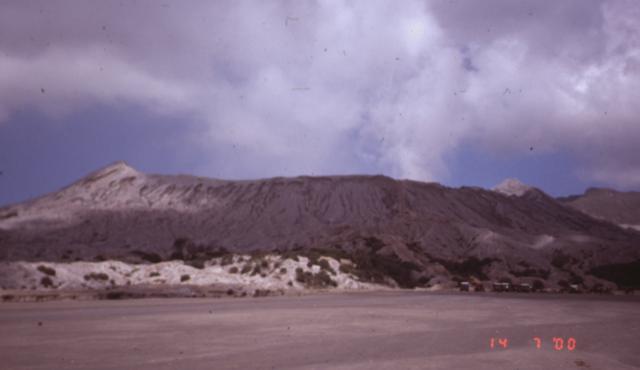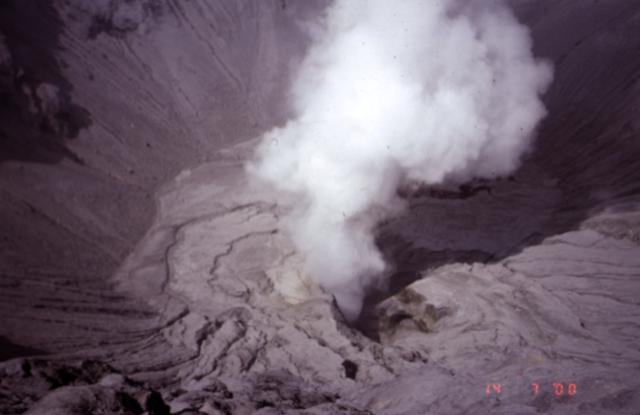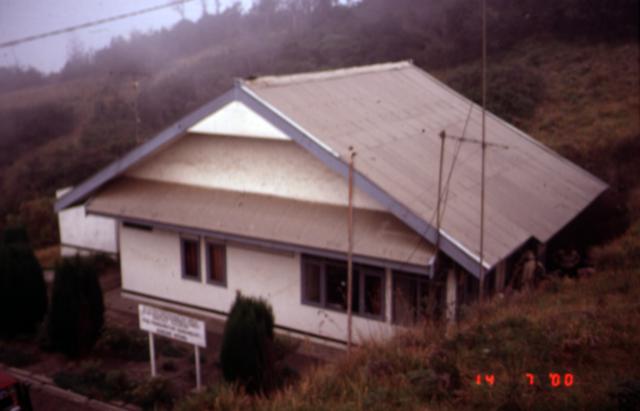Report on Tengger Caldera (Indonesia) — November 2000
Bulletin of the Global Volcanism Network, vol. 25, no. 11 (November 2000)
Managing Editor: Richard Wunderman.
Tengger Caldera (Indonesia) Sudden explosion 29 November; eruption continues as of 18 December
Please cite this report as:
Global Volcanism Program, 2000. Report on Tengger Caldera (Indonesia) (Wunderman, R., ed.). Bulletin of the Global Volcanism Network, 25:11. Smithsonian Institution. https://doi.org/10.5479/si.GVP.BGVN200011-263310
Tengger Caldera
Indonesia
7.942°S, 112.95°E; summit elev. 2329 m
All times are local (unless otherwise noted)
A minor explosion issued from Bromo, the youngest cone of the Tengger volcanic complex (figure 3), without warning on 29 November 2000. Activity leading up to the explosion was low, characterized by a white plume that rose ~50 m on a daily basis (figure 4). The seismograph for the area was in disrepair since 18 October, so no seismic data were available. The explosion initiated with dark ash rising 100-150 m. Ash ejection persisted, reached 600-700 m in height above the crater rim, and the plume drifted up to 40 km from Bromo, where ash was deposited in layers 1-3 cm thick. A volcanic ash advisory was issued to aviators due to a plume ~1.2 km above the summit. Pilots were encouraged to navigate around the plume in order to avoid a potentially dangerous encounter. Following the explosion, the Volcanological Survey of Indonesia (VSI) repaired and upgraded the seismograph on the volcano.
Ongoing explosions and continuous tremor accompanied the volcanic activity during 5-11 December. Explosion earthquakes had amplitudes of 4-30 mm, while tremor had amplitudes of 2-6 mm. As of 5 December, the ash ejection was dark gray-brown in color, and smelled strongly of sulfur. Ash plumes rose 150-900 m over the following week, and by 8 December, satellite imagery showed convective clouds in the vicinity, and volcanic ash advisories indicated that the ash cloud had drifted to ~6.8 km above and E of the summit. The hazard status for Bromo cone placed at 2 (on a 1-4 scale). Explosions and tremor activity were ongoing and increased during the week of 12-18 December. Small explosions sent gray-brown to dark gray ash 500-600 m above the crater rim. A sulfur odor continued to be smelled at the observatory on the caldera rim (figure 5). Amplitudes for explosion earthquakes and tremor earthquakes were 5-34 mm and 1-5 mm, respectively. The seismograph recorded an unprecedented 2,375 explosion earthquakes in addition to continuous tremor.
Geological Summary. The 16-km-wide Tengger caldera is located at the northern end of a volcanic massif extending from Semeru volcano. The massive volcanic complex dates back to about 820,000 years ago and consists of five overlapping stratovolcanoes, each truncated by a caldera. Lava domes, pyroclastic cones, and a maar occupy the flanks of the massif. The Ngadisari caldera at the NE end of the complex formed about 150,000 years ago and is now drained through the Sapikerep valley. The most recent of the calderas is the 9 x 10 km wide Sandsea caldera at the SW end of the complex, which formed incrementally during the late Pleistocene and early Holocene. An overlapping cluster of post-caldera cones was constructed on the floor of the Sandsea caldera within the past several thousand years. The youngest of these is Bromo, one of Java's most active and most frequently visited volcanoes.
Information Contacts: Dali Ahmad, Volcanological Survey of Indonesia (VSI), Jalan Diponegoro No. 57, Bandung 40122, Indonesia (URL: http://www.vsi.esdm.go.id/); Darwin Volcanic Ash Advisory Centre (VAAC), Bureau of Meteorology, Northern Territory Regional Office, PO Box 40050, Casuarina, NT 0811, Australia (URL: http://www.bom.gov.au/info/vaac/).




